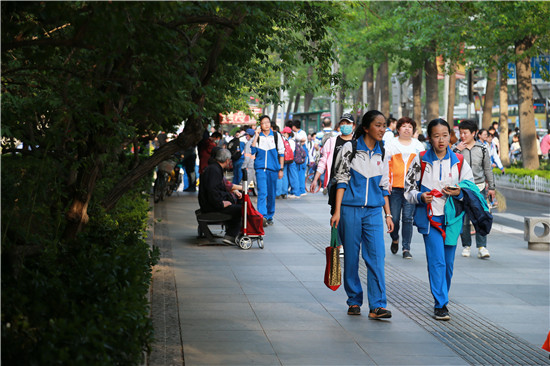What's in a uniform? First, it unifies. Instead of a smorgasbord of apparel causing the eye to notice the individual, requiring students to wear school uniforms unites the many into one visually identifiable body. Second, it standardizes. A standardized dress code such as a uniform ensures extremes are avoided. Instead of risking a student showing up to class in something outlandish, uniforms put those in power at ease knowing in advance what everyone will be wearing. Third, it simplifies. Students and parents alike need not over think or over spend when it comes to school attire. All involved are quite clear on appropriate attire. The process of picking out and deciding on what to wear each day becomes super simple.
 |
| Middle school students left school in unifrom |
Despite a few of the obvious benefits, uniforms aren't without a few setbacks. First, they can be a bit drab. Wearing virtually the same thing everyday isn't exciting. Especially for children who love to explore and discover different things, as time progresses wearing an old uniform day after day can seem a bit boring. Second, they usually aren't flattering. Students' bodies come in all shapes and sizes. It seems uniforms can't quite keep up. From too tight to too loose, school uniforms appear to have a sizing issue which leaves students looking anything but their best. As guys and girls grow up, they become increasingly sensitive to the way they look. Uniforms leave little room for personal preference. No matter how nasty a color may look or how formless those stretchy pants make a student seem, there is no choice but to wear the school uniform day after day. In extreme cases, wearing uniforms which aren't suited to the unique size and complexion of each student could be the spark that ignites an inferno of self-esteem problems. Third, they don't quite keep up with the times. Most uniforms look outdated. While constantly keeping up with the latest and greatest fad is hardly necessary, wearing a uniform that might have been stylish a few decades ago does nothing to boost student morale. Outdated uniforms also detract from the overall image of the school. Seeing an entire student body in a uniform from yesteryears might leave some questioning how relevant the rest of the school's policies are to the modern world. Education is a highly competitive, dog-eat-dog industry these days. Chinese parents and grandparents are ready to sacrifice life and limb to get their child into a top school which allegedly assures future success. Schools get scrutinized for what they have to offer in terms of return on investment. As petty as it may seem, outdated uniforms may indicate an educational institution is struggling to stay in touch with reality.
Public Opinion
Michael Pilgrim, a Canadian educator who has traveled the world teaching, offered the following comments about uniforms. "I spent 22 years at school without wearing a uniform. As an international teacher, I have taught in countries where uniforms were standard apparel, and upon further investigation, it seems the motive behind a 'uniform policy' is to eliminate class distinction-whether rich or poor-there should be no discrimination! The understanding was that rich kids would come to school wearing very expensive clothing, while their poorer classmates would look shabby in their hand-me-downs and feel inferior, so to eliminate embarrassment, a 'uniform policy' was implemented. However my experience teaching in countries where uniforms were required, was that you could ultimately identify students, simply based on the condition of their uniforms. Students from supportive families were always well-kempt, while many of the poorer students came to school disheveled. So to this point, it seems that ultimately; whether you wear a uniform or not; your standing in society becomes obvious!"
Rose a 44 year old housewife, who grew up in a rural school and now living in the city for the past 20 years, "feels that school uniforms are good especially from a security aspect. Once the students are dressed alike, it is much easier to identify them. Drivers of vehicles will pay great attention to a group of students dressed in uniforms rather than plain street clothes. Within the school, uniforms are slightly different for the [juniors] and seniors, this helps with identifying the different grades and organizing events. Also, if all students wear the same uniforms, you will be able to easily notice if an unwelcome [outsider] has entered the school premises."
Lisa is a 36 year old from Harbin and owns a Public Relations firm. "She thinks that having a common school uniform helps students maintain the same standard of class. No matter how rich or poor the student's family or level of social status, this disappears with the common uniform. The identical clothing will help establish a sense of team work and spirit towards a common goal and family. Students will have a greater feeling of sameness and belonging."
David who is closely involved with education felt: "Administratively, the implementation of uniforms will help the school administrators to control students. No need to implement dress codes and everything will be straight forward. Whereas in the West, teachers need to worry about the length of girls skirts, what types of slogans are allowed or restricted with t-shirts."
 |
| New style school uniform |
Conclusion
When it comes to uniforms, despite good intentions the results are questionable. Why? As Michael mentioned, even with uniforms, a student's social status is often exposed. While Rose proposed potential security benefits associated with school uniforms, the opposite could also be said. What if an uninvited guest used a school uniform to pose as a real student? With everyone looking so similar, it would be quite challenging to pick out an imposter. In fact, add a baseball cap and a backpack and probably anyone would have a very tough time identifying a person wearing a uniform as not belonging to a particular school. Lisa presented comments consistent with Michael's investigative results, but can't quite refute the reality stated, poorer children due to lack of proper care of the uniform may get identified anyways. David makes a good point in terms of uniforms offering administration a level of control over what students wear. However, there is still plenty of opportunity for mischievous students to cause commotion with their physical appearance. For example, shoes, backpacks, accessories, hair, makeup, piercings, and tattoos are all possibilities for offense no matter what uniform is required.
The bottom line is, uniforms reflect the common aspirations of many humans. These include control, equality, safety, and unity. It makes us consider other places where uniforms are common, such as the military, the post office, the police, firehouses, hospitals, airlines and the list goes on. In all cases, the reasons for requiring a uniform are probably about the same. Yet, uniforms alone are unable to instill in individual hearts the actual desire to conform, be impartial, obey, and unite. Outward appearances are simply not enough to ensure what's inside. Regardless of whether uniforms are required, emphasis must be placed on the curriculum and ideology being taught at schools. The relative equality provided by uniforms simply cannot ensure true social justice. Perhaps all too often, the rigid requirement of uniforms fails to delivery true uniformity.

 Culture
Culture




